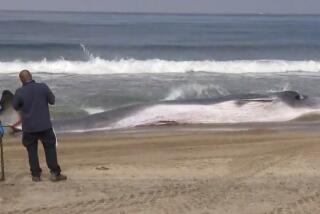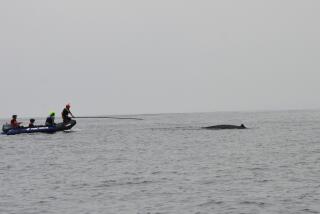Whales Finally on Their Way, Rescuers Say
POINT BARROW, Alaska — Two California gray whales trapped for three weeks by Arctic ice finally swam to freedom Friday, ending a million-dollar rescue effort watched around the world.
The breakthrough, confirmed by airplane and helicopter reconnaissance flights, climaxed a marathon rescue operation that combined the efforts of Eskimos, environmentalists, oil company experts, the U.S. military and Soviet icebreakers.
Earlier in the day, the whales had moved to within 100 yards of open water, then disappeared. Reconnaissance flights later detected “whale tracks”--a series of holes punched in thin ice by the whales as they surfaced to breathe while heading out of a wide channel cut by icebreakers through the Chukchi Sea.
“The whales are really gone for sure,” North Slope borough Mayor George Ahmaogak said. “They are really gone.”
U.S. whale rescue coordinator Ron Morris called the whales’ survival chances “pure speculation. They had the will to live. They should make it.”
Whether the whales survive probably will never be known because biologists chose not to tag them with radio transmitters to keep track of them.
Arnold Brower Jr., a prominent Alaska Eskimo whaling captain who helped devise the plan to save the whales, said he was confident that the two whales had reached the channel cut by two Soviet icebreakers.
Following Breaks in Ice
If the California gray whales follow the icebreakers’ channel, they will still have to navigate “leads,” natural breaks in the ice that vary greatly in width and close or open according to the wind, for about 200 miles.
Biologist Howard Braham, director of the National Oceanic and Atmospheric Administration’s National Marine Mammal Laboratory in Seattle, said he thought the whales could make the 200-mile journey.
The icebreakers spent much of the night plowing through the ice off Alaska’s northern coast to slice another escape route for the whales, originally trapped at a small breathing hole four miles from open water. A third whale trapped with them died earlier.
The two whales were last seen before dawn by Eskimos keeping a watch as the marine mammals bobbed in an air hole cut Thursday night by a Soviet icebreaker.
The whale tracks were spotted from the air at about noon, indicating that the animals had slipped away in the dark under 25 yards of thick ice separating them from the open channel.
That channel is covered by a thin layer of ice that gives way to open water, and it was in the thin ice that evidence of the whales’ surfacing was seen.
The Eskimos reported finding the whale tracks even before they were spotted from the air.
“I feel great. I feel like I got no more burden,” Brower said.
He said he got his news from a report by Ralph Malik, one of the Eskimos involved in the rescue effort who has been on the ice constantly and went back onto the floe before daylight.
“The whole effort has been great,” Brower said. “With all this much support, I think it’s been worthwhile for us. I think we all feel they are no longer trapped.”
A Soviet icebreaker using high-intensity lights in the icy night fog plowed back into a slushy Arctic channel Thursday night to as close as it could get in hopes of freeing the whales.
Officials wanted to move fast because of fears that the 200-mile channel into the North Pacific would freeze solid.
The early morning temperature dipped to 17 degrees below zero Friday, the end of the third week since the whales, late in starting their migration from the Arctic, were trapped by the ice pack.
More to Read
Sign up for Essential California
The most important California stories and recommendations in your inbox every morning.
You may occasionally receive promotional content from the Los Angeles Times.










